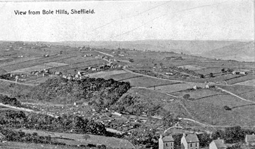Old View of Rivelin Valley from Bole Hills
Museum Surroundings and ViewsThe Museum stood on a generous plot of land, where fruit trees grew. From here, and especially from the upper windows, it enjoyed views over the Rivelin Valley and the Loxley Valley. The Rivelin Valley was not free of industrial activity at that time. It had long been a centre for knife grinders, who used the river water to power mill stones. The derelict cottages and grinding mechanisms still found along the river testify to their activities. But such small-scale industry did not interfere with Ruskin's impression of the valley as a pastoral scene.The view from the Museum reminded Ruskin of Alpine scenery, a source of childhood wonder as well as a subject of study in his art criticism. The effect was not exclusively visual: the fresh air blowing in from the Derbyshire hills ensured that the Museum's visitors would breathe a different atmosphere.For a Museum whose collections laid stress on the importance of studying natural forms, this location was more than a mere setting. It was, in a way, part of the displays. Ruskin thought of the Museum as an extra-mural device, a 'Place of Muses', rather than a confined space.
Victorian Walkley Through the Eyes of a Visiting ReporterIn 1886, The Pall Mall Gazette sent a reporter to visit Walkley. He described the 'beautiful scenery' in the Museum's locality, and included lines from a poem about the Rivelin Valley:'As for nature, all that visitors have to do is to look out of the museum windows or to walk -- as the two men in our next sketch have done -- in the surrounding fields. For the peculiarity of Sheffield among manufacturing towns is the close proximity to it of some of the most beautiful scenery in England, and it was for this reason among others that Mr. Ruskin selected Walkley for the home of the first St. George's Museum. From the front door to the right is an extensive view of the valley of the Don, with Wharncliffe crags far away in the distance; while to the left, and also to be seen from the museum windows, is that Rivelin Valley which Elliot the Corn-law rhymer made his favourite resort:-Oh that I were a primrose To bask in sunny air Far away from all the plagues that make Town dwelling men's despaire. Bell Hagg Road, Rivelin postmarked 1911 [image s13464 from the collections in Sheffield Local Studies Library, used with kind permission]
Image s11854 from the collections in Sheffield Local Studies Library, used with kind permission
'Afternoon Stroll from Sheffield', a sketch from 'St. George's Museums', Pall Mall Gazette, 14 May 1886 Or like a rainbow laughing O'er Rivelin and Don When misty morning calleth up Her mountains one by one.'['St. George's Museums', Pall Mall Gazette, 14 May 1886] The Rivelin Valley and Ebenezer ElliottEbenezer Elliot, the Corn-Law Rhymer mentioned above, was an iron-merchant who had taken up residence in Upperthorpe. In his most famous work, Corn Law Rhymes (1831) he campaigned against the Corn Laws, which he regarded as a subsidy for the rich and a 'bread-tax' on the poor. When he was not tending his business or rhyming, he spent time botanising in the Rivelin Valley. His biographer, John Watkins, describes a walk that the pair took there in December 1838:'After breakfast we sallied forth, and took our course up a hill, till the vale of the Rivilin [sic] opened to our view, which he described with the eye of a painter. The mills on the stream, and the weirs belonging to them, made a succession of beautiful landscapes. We looked in at one of those mills, and saw an old man of thirty, a grinder. He said they seldom reached forty, yet would not use the grinder's life-preserver [...] We walked about five miles up the valley, till we came to a streamlet which he had christened Ribbledin, from the music of its waters as it flowed. We came to a little waterfall at the head. He said it was Nature's boudoir, and indeed, it might have served for a fountain for Diana. After crossing the stream on bridges of fallen trees, and remarking the great age of the hollies, we clambered, with some difficulty, which he made light of, up a rocky ascent, and returned by the moors' (John Watkins, Life, Poetry, and Letters of Ebenezer Elliott, The Corn-Law Rhymer (London: John Mortimer, 1850), pp. 141-2 |



















